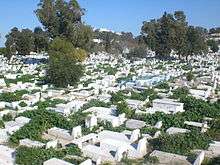Jellaz Cemetery

Jellaz Cemetery (also known as al-Jallaz) is a large hillside Muslim cemetery in Tunis, Tunisia, established in the thirteenth century. Located next to the bus station, the cemetery is the largest in the city. The Borj Ali Rais Ottoman fortress is visible from most places in the cemetery.[1] Visiting the cemetery is a duty during Aid el Fitr at the end of Ramadan. Family members at this time clean and paint the tombs, which face Mecca.
In 1911, mass protests known as the Jellaz Affair demonstrations took place at the cemetery against the French, triggered by land registration and entitlement disputes. These in turn led to the Tunis Tram Boycott,.[2] A bloody confrontation took place after the burial of the wife of an eager propagandist of naturalisation and resulted in the death of 39 people, 9 of them French and 5 of them Italian.[1][3]
Notable burials
- Youssef Alouane, academic, communicator and chairman of the Higher Communication.[4]
- Mohamed Brahmi, politician,founder and former leader of the People's Movement.
- Chokri Belaid, lawyer and politician.
- Henri Kassagi (Abdelmaǧīd al-qaṣʿaǧī), magician and artist.
References
- 1 2 Jacobs, Daniel, Morris, Peter (2001). Rough Guide to Tunisia (6 ed.). Rough Guide Travel Guides. p. 94. ISBN 1-85828-748-0.
- ↑ "The Young Tunisians movement". Tunisia Association. Retrieved July 27, 2010.
- ↑ Tunisia. Eyewitness Guides. 2008. p. 87.
- ↑ "Funeral of Youssef Alouane". News.Marweb.com. February 25, 2010. Archived from the original on July 14, 2011. Retrieved July 27, 2010.
External links
Coordinates: 36°47′10″N 10°11′04″E / 36.78611°N 10.18444°E